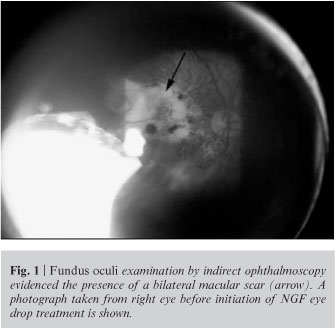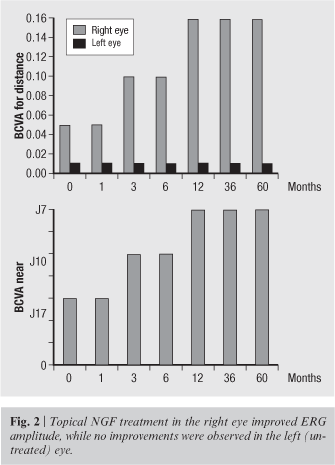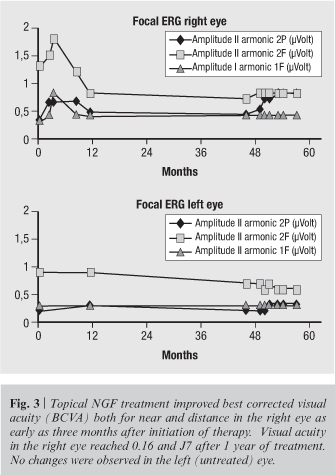BRIEF NOTES
Nerve growth factor eye drops improve visual acuity and electrofunctional activity in age-related macular degeneration: a case report
Il fattore di crescita nervosa in collirio migliora l'acuità visiva e l'attività elettrofunzionale nella degenerazione maculare senile: un case report
Alessandro LambiaseI; Marco CoassinI; Paola TirassaII; Flavio MantelliI; Luigi AloeII
IDipartimento di Oftalmologia, Università Campus Biomedico, Rome, Italy
IIIstituto di Neurobiologia e Medicina Molecolare, Consiglio Nazionale delle Ricerche (CNR), Rome, Italy
SUMMARY
Age-related macular degeneration (ARMD) is a severe disease affecting visual function in the elderly. Currently available surgical and medical options do not guarantee a significant impact on the outcome of the disease. We describe the effects of nerve growth factor eye drop treatment in a 94 years old female with ARMD, whose visual acuity was progressively worsening in spite of previous surgical and medical treatments. NGF eye drops improved visual acuity and electrofunctional parameters as early as 3 months after initiation of treatment. These results are in line with previous reports on a neuroprotective effect of NGF on retinal cells and on NGF eye drops bioavailability in the retina and optic nerve. No side effects were observed after five years of follow-up, suggesting that topical NGF treatment may be a safe and effective therapy for ARMD.
Key words: macular degeneration, nerve growth factor, visual pathways, retina, eye drops.
RIASSUNTO
La degenerazione maculare senile (DMLE) rappresenta una patologia della terza età ad elevato impatto sociale che determina una grave riduzione della funzione visiva. Attualmente non vi sono terapie mediche o chirurgiche sicuramente in grado di arrestarne la progressione. In questo studio descriviamo l'effetto della somministrazione di NGF in collirio in una paziente di 94 anni affetta da DMLE, con un quadro clinico progressivamente ingravescente nonostante fosse stata sottoposta ad interventi chirurgici. Il trattamento con NGF ha determinato un miglioramento dell'acuità visiva e dei parametri elettrofunzionali retinici già dopo 3 mesi. Questo risultato è in linea con dati sperimentali che dimostrano come l'NGF in collirio raggiunga la retina ed il nervo ottico, dove svolge un ruolo neuroprotettivo. Gli effetti benefici dell'NGF sono perdurati per tutto il periodo di follow-up (6 anni) in assenza di effetti collaterali. Questo dato suggerisce la possibilità di un utilizzo terapeutico dell'NGF in collirio per patologie degenerative retiniche.
Parole chiave: degenerazione maculare, fattore di crescita nervosa, vie ottiche, retina, gocce oftalmiche.
INTRODUCTION
A consistent number of studies published in recent years have demonstrated that topical administration of nerve growth factor (NGF) to the eye is a safe therapy able to restore corneal integrity in patients with neurotrophic ulcers [1-3]. The healing properties of NGF have also been reported in cutaneous ulcers caused by diabetes, rheumathoid arthritis and pressure ulcers [4-9]. More recently, studies in animal models of ocular hypertension and glaucoma have shown that retinal cells express NGF receptors and that the degeneration of these cells can be protected by NGF eye drop administration [10, Based on these data we hypothesized that topical NGF administration to the eye could be a novel therapeutic approach for human macular degeneration.
Age-related macular degeneration (ARMD) is the most common cause of irreversible visual loss in the elderly in the developed countries, and its incidence is constantly increasing [12]. Loss of vision due to ARMD occurs either as a result of choroidal neovascularisation with exudation and haemorrhage ("wet" ARMD) or by slow atrophy of the retinal-pigment epithelium and overlying receptors ("dry" ARMD) [13]. Definitive treatment does not yet exist. About 10% of patients with wet ARMD who present early with distorted vision and an eccentric neovascular lesion can be treated with laser photocoagulation. However, the recurrence rate is over 60%, with further vision being usually lost [14]. Selected patients can also be treated with photodynamic therapy involving low-intensity red laser treatment after intravenous verteporfin infusion, but the functional benefit is usually modest [15]. In the last few years, treatment with repeated intravitreal injections of anti-angiogenic compounds has also been proposed, with substantial success in reducing progression of disease [16, 17]. Nevertheless, several alternative pharmacological interventions are in different phases of clinical development, and researchers are guardedly optimistic that these advances may change the entire approach to ARMD management in the near future.
Based on our long-lasting experience on the healing action of NGF in corneal ulcers, and the evidence that this form of NGF application does not exert side effects or generate circulating NGF antibodies [1], the possible use of topical NGF in ARMD was taken into consideration. The effect of eye NGF treatment was valuated in a 94 years old female patient affected by maculopathy for over three years characterized by progressive worsening of visual acuity and macular degeneration as evidenced by clinical and electrofunctional tests. Moreover, since all available therapies failed to arrest or delay the visual field worsening induced by the maculopathy, informed signed consent was obtained and the patient was treated TID with NGF eye drops. The effects of therapy were followed closely every-other day for the first three weeks and every 3 months thereafter.
The results of this case report are based on the evaluation of visual acuity and electrofunctional parameters during 6 years of NGF treatment.
MATERIALS AND METHODS
A 94 years old female affected by bilateral wet ARMD since 1995 referred to our Department following macular cryotreatment in left eye (in 1996), and laser and photodynamic treatment in right eye (in 2000 and 2001, respectively). Cataract surgery was performed in both eyes (in 2001). Eye examination showed the presence of bilateral macular scar with no evidence of neovascularisation (Figure 1). Fluorescein examination confirmed a central extensive area of retinal atrophy with the absence of choroidal neovascularization. Best corrected visual acuity (BCVA) was 0.05 in right eye and count finger in left eye. J17 was the near visual acuity detectable in the right eye, while it was not detectable in the left eye. At baseline, electrofunctional exams showed a decrease of ERG amplitude (Figure 2).


After all currently available therapies failed to block or delay the visual deficits induced by ARMD progression, the patient signed informed consent to be treated with NGF eye drop on a compassionate basis. Highly purified NGF was prepared following the Bocchini&Angeletti method, as reported in our previous studies. [3. 8, 18] Lyophilized NGF was dissolved in physiological saline solution and one drop (approximately 50 ml of 200 mg/ml was administrated TID into the conjunctival fornix of the right eye.
RESULTS
The patient was evaluated at baseline and every three months during NGF treatment and the follow-up (6 years) by complete ocular examination including BCVA and electrofunctional exams. No ocular adverse side effects were observed during the treatment and follow-up. Macular morphology was unchanged at the end of follow-up. However, after 3 months of NGF treatment an improvement of ERGamplitude was observed (Figure 2), followed by an increase of visual acuity in the right eye that reached 0.16 and J7 after 1 year of treatment. No changes were observed in the left eye.
At 1 year of NGF treatment, patient discontinued NGF eye drop for 3 months. Interestingly, the follow-up visit at 3 months of NGF discontinuation showed decreased ERG amplitude, associated with a decreased visual acuity. Thus, patient re-started NGF eye drop treatment and after 3 months of treatment ERG amplitude and visual acuity increased again. At 18 months of NGF treatment both BCVA and ERG value were stable. No morphological changes were observed in the retina of both eyes.
The only side effect recorded during the 6 years of NGF treatment was a weak burning sensation at the time of administration that persisted for the 1st month of treatment.
DISCUSSION
Nerve growth factor (NGF) is an endogenous neurotrophin that exerts trophic and differentiative activity on neurons of the central and peripheral nervous systems with protective and/or regenerative effects observed in degenerative diseases or following injury [6, 19-23]. Intraocular administration of NGF in animal models has been shown to inhibit retinal ganglion cell degeneration [24, 25]. Despite the numerous data showing NGF abilities in protecting and recovering retina and optic nerve from injury and/or degeneration, invasive routes of administration, such as intraocular injection, or intraocular insert releasing the growth factors, are not optimal for clinical use. Recently, NGF applied topically to the eye has also been shown to reach the retina, optic nerve and brain [26, 27], indicating that NGF eye drops could be a novel therapy for the treatment of ocular and brain degenerative diseases.

In this study, we report the case of a patient with advanced bilateral ARMD who improved both her BCVA and electrofunctional parameters with TID topical NGF administration in one eye for 5 years, without reporting any side effect except for a mild and transient burning sensation at the site of administration for one month after initiation of treatment.
The efficacy of NGF in improving visual acuity and electrofunctional parameters has been observed in this patient at 3 months after initiation of treatment. This "early" effect of NGF treatment is in line with the NGF action in supporting trophism and functions of central and peripheral neurons in vitro as well as in vivo [22, 28, 29]. Specifically, several studies have demonstrated a biological activity of NGF in protecting retinal ganglion cells against ischemic, traumatic and hypertensive injuries [24, 25, 30]. This neuroprotective properties of NGF make it a strong candidate for the future treatment of degenerative diseases (such as glaucoma). In fact, it is also noteworthy that in the course of NGF eye drops treatment or during the follow up, no NGF antibodies were detected in serum, as the murine NGF presents great homology with human NGF and the amount of topically-applied NGF reaching the bloodstream is absent or too low to trigger anti-NGF-antibodies formation [1].
A key question raised by this clinical observation and also by studies on animal models [10, 11, 27, 31], is how NGF, a high-molecular-weight protein, is transported from the ocular surface to the posterior segment of the eye when administered topically as eye drops. The evidence currently available points out to two possibile routes: through the cornea, conjunctiva, sclera, choroid, choriocapillaris, and retinal pigment epithelium, or indirectly by traveling through the retrobulbar space to the optic nerve.
Although the clinical observation presented in this report needs to be confirmed on a large scale clinical trial, the good clinical response and the persisting of the improvement during the follow-up stimulate to extend our pilot clinical study. Moreover this study confirms the possibility of using the eye drop NGF for reaching retina, optic nerve and brain in a safe and non-invasive manner, supporting the potential use of topical NGF therapy for ocular and brain degenerative diseases currently considered untreatable.
References
1. Lambiase A, Coassin M, Sposato V, Micera A, Sacchetti M, Bonini S, Aloe L. NGF topical application in patients with corneal ulcer does not generate circulating NGF antibodies. Pharmacol Res 2007;56:65-9.
2. Lambiase A, Manni L, Rama P, Bonini S. Clinical application of nerve growth factor on human corneal ulcer. Arch Ital Biol 2003;141:141-8.
3. Lambiase A, Rama P, Bonini S, Caprioglio G, Aloe L. Topical treatment with nerve growth factor for corneal neu-rotrophic ulcers. N Engl J Med 1998;338:1174-80.
4. Generini S, Tuveri MA, Matucci Cerinic M, Mastinu F, Manni L, Aloe L. Topical application of nerve growth factor in human diabetic foot ulcers. A study of three cases. Exp Clin Endocrinol Diabetes 2004;112:542-4.
5. Aloe L. Nerve growth factor, human skin ulcers and vascularization. Our experience. Prog Brain Res 2004;146:515-22.
6. Micera A, Lambiase A, Stampachiacchiere B, Bonini S, Levi-Schaffer F. Nerve growth factor and tissue repair remodeling: trkA(NGFR) and p75(NTR), two receptors one fate. Cytokine Growth Factor Rev 2007;18:245-56.
7. Aloe L, Tuveri MA. Nerve growth factor and autoimmune rheumatic diseases. Clin Exp Rheumatol 1997;15:433-8.
8. Bernabei R, Landi F, Bonini S, et al. Effect of topical application of nerve-growth factor on pressure ulcers. Lancet 1999;354:07.
9. Tuveri M, Generini S, Matucci-Cerinic M, Aloe L. NGF, a useful tool in the treatment of chronic vasculitic ulcers in rheumatoid arthritis. Lancet 2000;356:1739-40.
10. Coassin M, Lambiase A, Sposato V, Micera A, Bonini S, Aloe L. Retinal p75 and bax overexpression is associated with retinal ganglion cells apoptosis in a rat model of glaucoma. Graefes Arch Clin Exp Ophthalmol 2008;246:1743-9.
11. Sposato V, Bucci MG, Coassin M, Russo MA, Lambiase A, Aloe L. Reduced NGF level and TrkA protein and TrkA gene expression in the optic nerve of rats with experimentally induced glaucoma. Neurosci Lett 2008;446:20-4.
12. Taylor HR, Keeffe JE. World blindness: a 21st century perspective. Br J Ophthalmol 2001;85:261-6.
13. Jager RD, Mieler WF, Miller JW. Age-related macular degeneration. N Engl J Med 2008;358:2606-17.
14. Ho AC. Laser treatment in eyes with drusen. Curr Opin Ophthalmol 1999;10:204-8.
15. Soubrane G, Bressler NM. Treatment of subfoveal choroidal neovascularisation in age related macular degeneration: focus on clinical application of verteporfin photodynamic therapy. Br J Ophthalmol 2001;85:483-95.
16. Brown DM, Kaiser PK, Michels M, et al. Ranibizumab versus verteporfin for neovascular age-related macular degeneration. N Engl J Med 2006;355:1432-44.
17. Rosenfeld PJ, Brown DM, Heier JS, et al. Ranibizumab for neovascular age-related macular degeneration. N Engl J Med 2006;355:1419-31.
18. Bocchini V, Angeletti PU. The nerve growth factor: purification as a 30,000-molecular-weight protein. Proc Natl Acad Sci USA 1969;64:787-94.
19. Apfel SC, Kessler JA, Adornato BT, Litchy WJ, Sanders C, Rask CA. Recombinant human nerve growth factor in the treatment of diabetic polyneuropathy. NGF Study Group. Neurology 1998;51:695-702.
20. Connor B, Dragunow M. The role of neuronal growth factors in neurodegenerative disorders of the human brain. Brain Res Brain Res Rev 1998;27:1-39.
21. Chiaretti A, Piastra M, Caresta E, Nanni L, Aloe L. Improving ischaemic skin revascularisation by nerve growth factor in a child with crush syndrome. Arch Dis Child2002;87:446-8.
22. Di Fausto V, Fiore M, Tirassa P, Lambiase A, Aloe L. Eye drop NGF administration promotes the recovery of chemically injured cholinergic neurons of adult mouse forebrain. Eur J Neurosci 2007;26:2473-80.
23. Williams BJ, Eriksdotter-Jonhagen M, Granholm AC. Nerve growth factor in treatment and pathogenesis of Alzheimer's disease. Prog Neurobiol 2006;80:114-28.
24. Lambiase A, Centofanti M, Micera A, Manni GL, Mattei E, De Gregorio A, de Feo G, Bucci MG, Aloe L. Nerve growth factor (NGF) reduces and NGF antibody exacerbates retinal damage induced in rabbit by experimental ocular hypertension. Graefes Arch Clin Exp Ophthalmol 1997;235:780-5.
25. Siliprandi R, Canella R, Carmignoto G. Nerve growth factor promotes functional recovery of retinal ganglion cells after ischemia. Invest Ophthalmol Vis Sci 1993;34:3232-45.
26. Lambiase A, Tirassa P, Micera A, Aloe L, Bonini S. Pharmacokinetics of conjunctivally applied nerve growth factor in the retina and optic nerve of adult rats. Invest Ophthalmol Vis Sci 2005;46:3800-6.
27. Lambiase A, Pagani L, Di Fausto V, Sposato V, Coassin M, Bonini S, Aloe L. Nerve growth factor eye drop administrated on the ocular surface of rodents affects the nucleus basalis and septum: biochemical and structural evidence. Brain Res 2007;1127:45-51.
28. Shimohama S, Ogawa N, Tamura Y, Akaike A, Tsukahara T, Iwata H, Kimura J. Protective effect of nerve growth factor against glutamate-induced neurotoxicity in cultured cortical neurons. Brain Res 1993;632:296-302.
29. Verge VM, Merlio JP, Grondin J, Ernfors P, Persson H, Riopelle RJ, Hokfelt T, Richardson PM. Colocalization of NGF binding sites, trk mRNA, and low-affinity NGF receptor mRNA in primary sensory neurons: responses to injury and infusion of NGF. J Neurosci 1992;12:4011-22.
30. Carmignoto G, Maffei L, Candeo P, Canella R, Comelli C. Effect of NGF on the survival of rat retinal ganglion cells following optic nerve section. J Neurosci 1989;9:1263-72.
31. Lambiase A, Aloe L, Centofanti M, Parisi V, Mantelli F, Colafrancesco V, Manni GL, Bucci MG, Bonini Dt, LeviMontalcini T. Experimental and clinical evidence of neuroprotection by nerve growth factor eye drops: Implication for galucoma. PNAS 2009;106:13469-74.
 Address for correspondence:
Address for correspondence:
Luigi Aloe
Istituto di Neurobiologia e Medicina Molecolare, CNR
Via Fosso del Fiorano 64/65, 00143 Rome, Italy.
E-mail: luigi.aloe@inmm.cnr.it.
Received on 15 June 2009.
Accepted on 20 July 2009.
